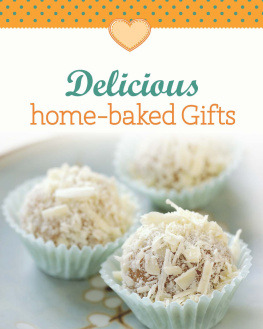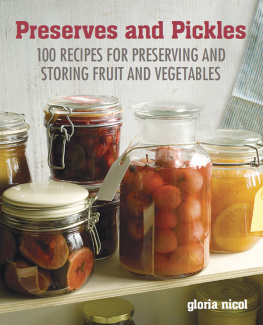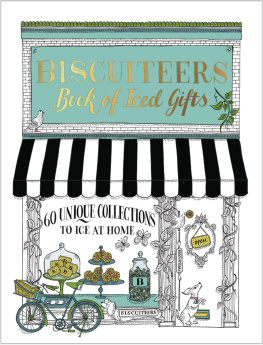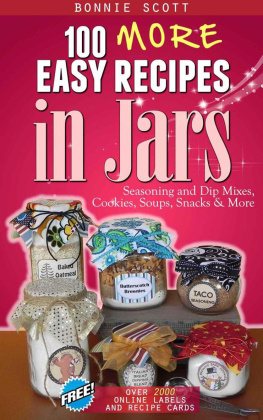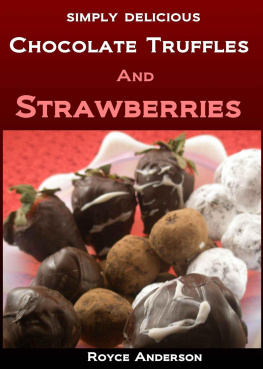Contents
Delicious
home-baked Gifts
Whether you want to give a small present, surprise someone or say thank you, making something yourself always makes it extra special and its all the rage! From indulgent treats like chocolates, biscuits, fruit preserves and delicious jams to savoury and sweet snacks, this selective recipe collection contains tasteful gifts for every occasion. All of these delicacies are mouthwateringly good and are sure to delight the recipient with their personal touch.
Delicious
home-baked Gifts
Naumann & Gbel Verlagsgesellschaft mbH
a subsidiary of VEMAG Verlags- und Medien Aktiengesellschaft
Emil-Hoffmann-Strae 1, 50996 Cologne (Germany)
www.vemag-medien.de
Translation from German: Maisie Fitzpatrick in association with First Edition Translations Ltd, Cambridge
Complete production: Naumann & Gbel Verlagsgesellschaft mbH
All rights reserved
ISBN 978-3-8155-8787-4
Picture credits
Food photography Michael Brauner: pages 3 (top),
Studio Klaus Arras: pages
Cover photo: StockFood/Alain Caste
TLC Fotostudio: all other photos
Scrumptious gifts
There used to be a time when home-baked gifts were commonplace people often had the ingredients growing in their own gardens, so it made sense to make things themselves. Sadly, today things have changed: people complain that they have too little free time and too little inspiration to do anything but shop for a somewhat characterless gift for a particular occasion. This makes the delight all the greater when someone actually dons their apron and surprises their loved ones with a home-baked present. Such gifts range from treats like chocolates and jams, for those with a sweet tooth, to pickled vegetables and savoury and sweet nibbles for a movie night or a quick snack.
You will need to note down a few important points in order to ensure that your culinary gifts go down a storm, especially when it comes to preserving and bottling. Below are put together useful tips to help you make your home-made presents.
Tips for preserving and bottling
In order to ensure that preserves keep for as long as possible, a careful choice of ingredients is vitally important. Kitchen hygiene is also essential. Particular attention should be given to cleaning the jars, while cleanliness is also paramount when preparing and closing the containers.
Only use top quality ingredients
In order to make delicious jams, compotes and jellies, good-quality fruit is crucial. Always buy fresh produce without bruises or rotten or musty patches. Wash the fruit thoroughly before use, and remove any that are damaged. The best-tasting spreads are made from ripe, freshly-picked fruit.
Suitable containers
For bottling you can use special bottling jars, or simply jars with a screw cap. Only use jars that have no signs of damage. The size of the jars is really up to you, but smaller jars are ideal, as the contents can be used up quickly once they have been opened.
Cleanliness is crucial
Jars and bottles must be thoroughly cleaned before they are filled. If the preserved food is poured into jars when boiling hot, it is sufficient to rinse the jars carefully with hot water and a commercial detergent before use, then rinse again thoroughly with clean hot water and drain upside down on a clean tea towel. If the jars are washed in the dishwasher they should be rinsed again, as detergent residue can affect the gelatinisation process. If the preserve is not going to be boiling hot, the jars should also be sterilised. The easiest method of sterilising is to put the jars and their lids in a preheated oven at 180 C for 15 minutes.
All of the germs are killed by the heat. You could also place the jars and lids in a large pot, cover with water and bring to a boil. Leave for approximately 5 minutes, then stand in the hot water until required. Another easy method is to half-fill the jars with hot water and then heat in a 600 Watt microwave and let the water boil briefly.
Pouring in the preserve
Before pouring the preserve into the containers you should test whether the fruit mixture is firm enough. Place 12 teaspoons of the marmalade, jam or jelly on a cold plate in order to test the gel point. If the mixture does not run and forms a thin skin, it has reached the required level of gelatinisation.
Cleanliness is vital when pouring the mixture into the jars. After filling them, wipe the glass rim clean, as any traces may offer a great target for germs. Close immediately with the hot lid and stand upside down for 5 minutes. This will create a germ-free vacuum that ensures that the contents will keep for a long time.
If you want to boil down a compote or raw fruit, the best method is to use a special pressure pot. The mixture is poured into preserving jars, with a new, moist rubber ring placed within the lid and fixed with a clamp. They are then boiled in the pot according to the instructions. Alternatively, you could do this in a drip pan in an oven. Line the drip pan with a tea towel, place the jars on top and fill the drip pan with water. Heat the oven to 175C (top and bottom heat) and keep the temperature steady until the air bubbles rise in the jars. If you are using fruit, you should turn off the oven at this point and leave the jars to stand in the oven for 30 minutes. Then remove the jars and take off the clamps only once they are cool. Check the lids for tightness and label the jars.
Correct storage
Keep your jars somewhere dark, cool and dry. Check them every now and then for mould and check regularly that the jars are still sealed. Gases emitted by mould and rot will cause the lids to bulge upward, therefore that the jars are no longer airtight. If the jars remain unopened, the contents will keep for several months. However, if they are stored for too long they will lose their flavour. Once opened, the jars should always be kept in a refrigerator.

